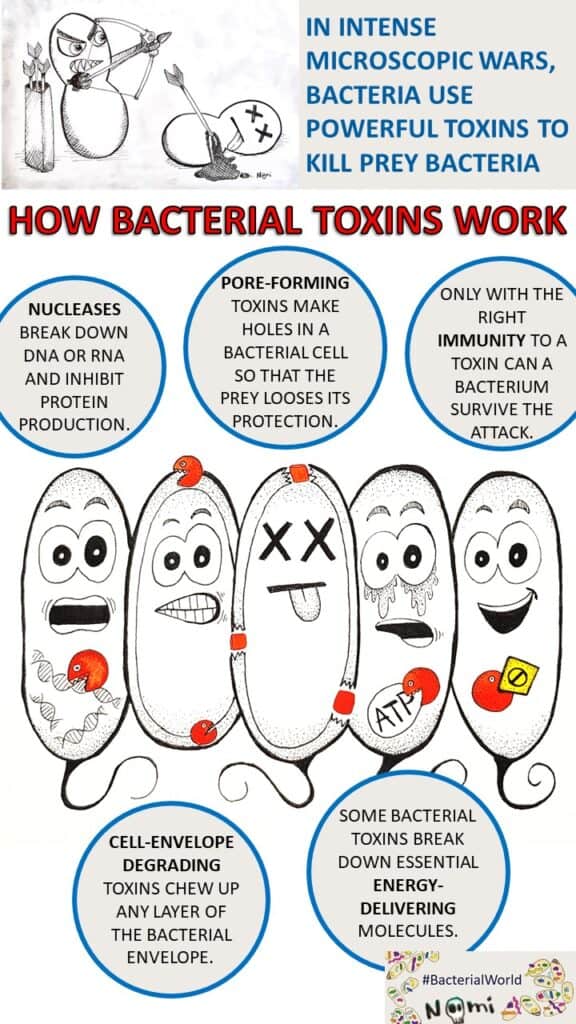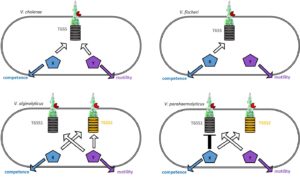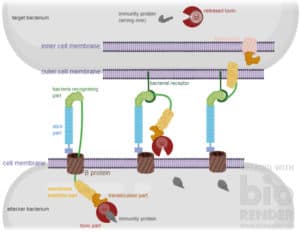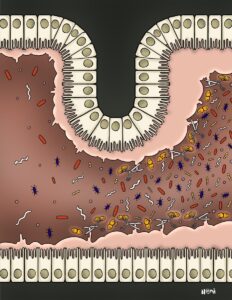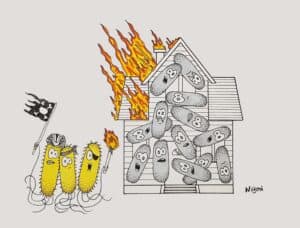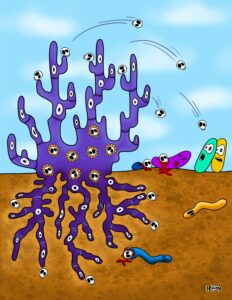In this blog, we talk a lot about how bacteria interact with each other and fight each other. And we look at different ways of how bacteria deliver toxins to the competitors.
They might be crossbows and arrows, lethal sticks or chemical molecules. All these weapons are different means for bacteria to deliver toxins – or their bullets – into their prey.
But these toxic bullets are what finally kills the prey. And these molecules can act completely different within the prey cell.
So, here we want to look into what exactly bacterial toxins are and what they do once they reach the other cell.
What are bacterial toxins?
Here, we will focus on toxins that harm bacteria or other microbes. Bacteria also produce toxins that they deliver into human cells and yes, sometimes these have similar activities. However, we will not include these here.
Another note to consider: As we said, these toxins are meant to kill bacteria. Hence, the producing bacterium needs to be safe from the toxin as well. So, whenever a bacterium produces a toxin, it also produces a so-called immunity or anti-toxin. This is a protein that binds to the toxin and neutralizes it. Like this, the toxin is inactive and no danger to the producing cell.
So, what sort of compound is a toxin actually.
Most toxins are proteins with enzymatic activities. In general, enzymes catalyse biological reactions using two substrates and fuse them together or break them apart.
However, enzymatic activities of toxins often break up components that are essential for life. And if this essential component is not present anymore, the cell cannot survive. So, like this, toxins are what ultimately kill prey cells.
Currently, researchers know of a few classes of bacterial toxins. Yet, they keep finding more and more.
Bacteria deliver different classes of toxins
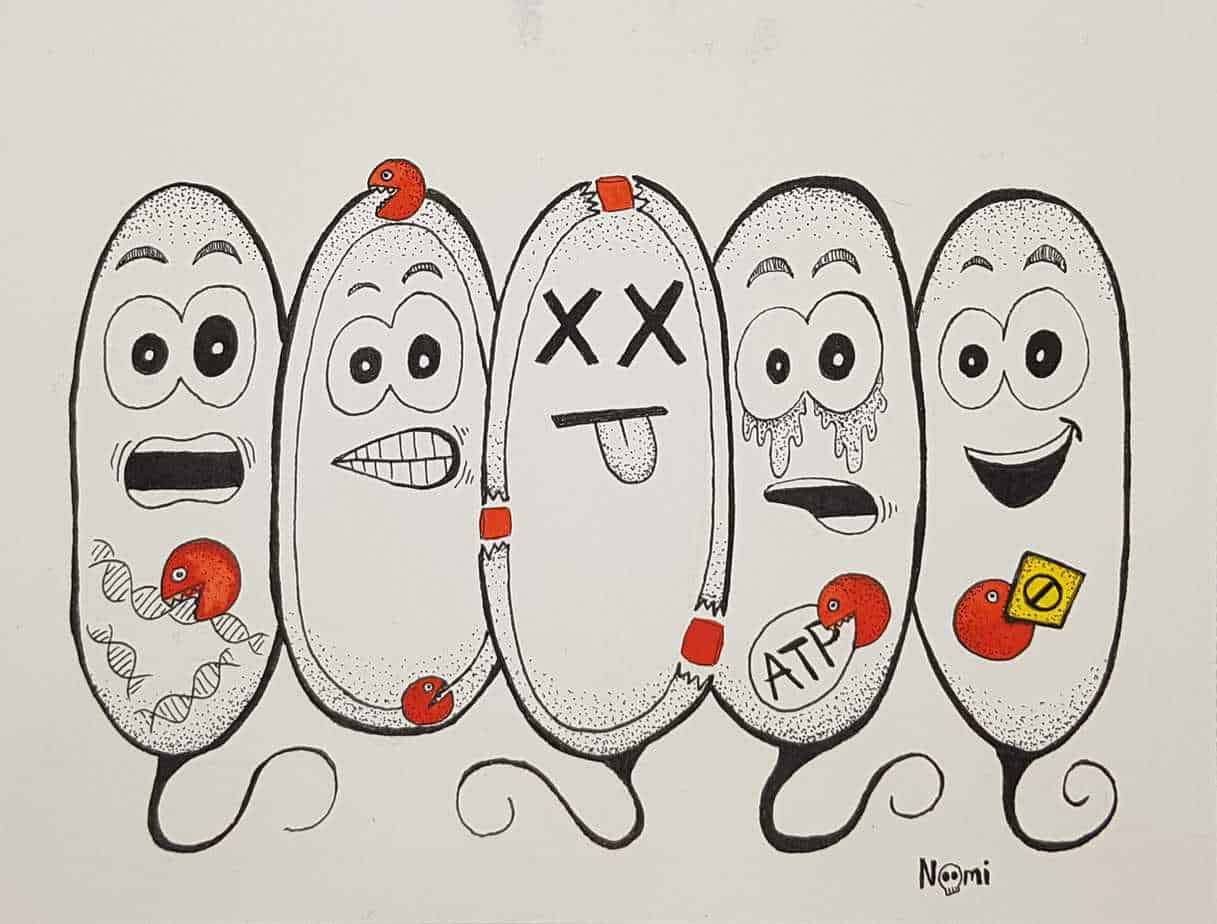
Nucleases
DNA is “the molecule of life”. Hence, it makes perfect sense that destroying this essential molecule kills a prey bacterium. Indeed, the most potent toxins are nucleases that break up DNA inside a bacterium. If there is no DNA inside a bacterial cell, the cell cannot produce any proteins and enzymes to stay alive.
To make proteins out of DNA, another step is essential: the production of RNA out of DNA. RNA and DNA are both nucleic acids (which is why these toxins are called nucleases), but RNA is the transcript for the cell machinery to produce proteins. Hence, some nucleases do not break up DNA, but they specifically chew up the RNA in a bacterial cell.
The outcome is basically the same; the bacterium cannot produce any protein and will eventually die. So, nucleases destroy the roots of every living cell.
Bacteria deliver nuclease toxins to destroy the DNA or RNA of the prey and stop it from producing proteins.
Cell-envelope degrading toxins
The cell envelope is what keeps all the components within the bacterial cell together, gives a bacterium its shape and protects a cell from the surrounding. Just as your skin keeps your whole body together and protects it from the outside. This makes the bacterial cell envelope another easy target to destroy a bacterium.
Depending on whether a bacterium belongs to the Gram-positive or Gram-negative category, it has one or two layers of the cell envelope. Gram-positive bacteria usually have one thick and rigid cell wall, while Gram-negative bacteria have two cell membranes between, the-called periplasm. Within the periplasm is some kind of loose mesh that holds the inner and outer membrane together.
Researchers found lots of toxins that can break up any of these layers. Some toxins can specifically chew up the thick and rigid cell walls of Gram-positive bacteria. Other toxins aim at one of the two membranes of Gram-negative bacteria or the mesh component in the periplasm.
In each case, the toxin has an enzymatic activity, that breaks up the molecule of which the layer is made.
So, some bacteria deliver toxins to chew up layers of the bacterial envelope.
Pore-forming toxins
Pore-forming toxins actually do not have enzymatic activity. Instead, they have the unique ability to form holes in a bacterial cell envelope. When a bacterium has holes in its cell envelope, the cell content leaks to the outside. Also, the liquid from the environment can stream into the cell and eventually burst the prey cell.
Thus, some toxins make holes in the bacterial cell envelope so that the bacterium loses its shape and protection.
Cell-function inhibitors
These kinds of toxins are the most versatile since many ways exist to inhibit the functioning of a cell. We will focus only on a few toxins here. But keep in mind that for some toxins, researchers still don’t completely understand how they work.
Most of these toxins have one thing in common: They break up or inhibit an essential molecule within the bacterial cell. As such, a lack of this molecule stops the bacterium from functioning or growing.
For example, to produce proteins, every cell needs ATP. This is the molecule in which cells store energy. Researchers just recently found one toxin that destroys ATP molecules within a prey cell. This makes it impossible for the prey to produce any more proteins. And we already know how his story ends.
Other toxins break down essential cofactors. Cofactors are vitamins, which every cell requires for example for cellular respiration. If a cell cannot perform cellular respiration, it does not produce ATP. And if a cell does not have any ATP? You know it ? !
Some bacteria deliver toxins to break up essential molecules in the prey and stop it from growing.
Bacteria deliver toxins for a good kill
You see the pattern here, right?
Whenever bacteria deliver toxins into prey bacteria, they want to hurt them real bad. This means, that a toxin generally targets any of the essential components of the prey bacterium to make sure there is no chance of survival.
So, even though we talk a lot about the weapons that bacteria use to kill their prey, it is ultimately the toxins that kill!

